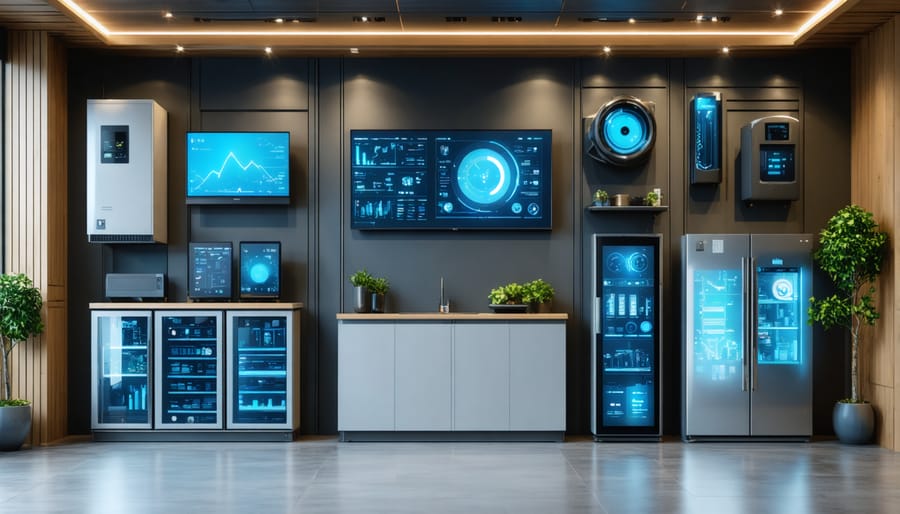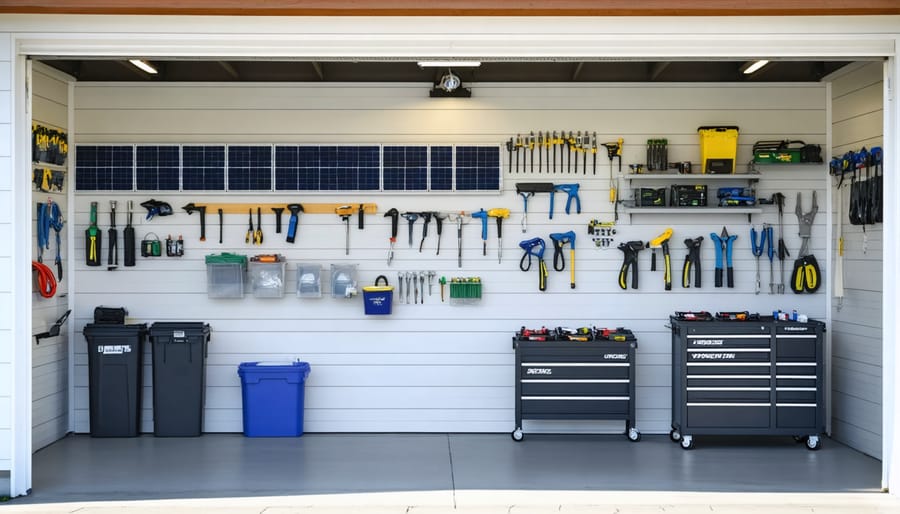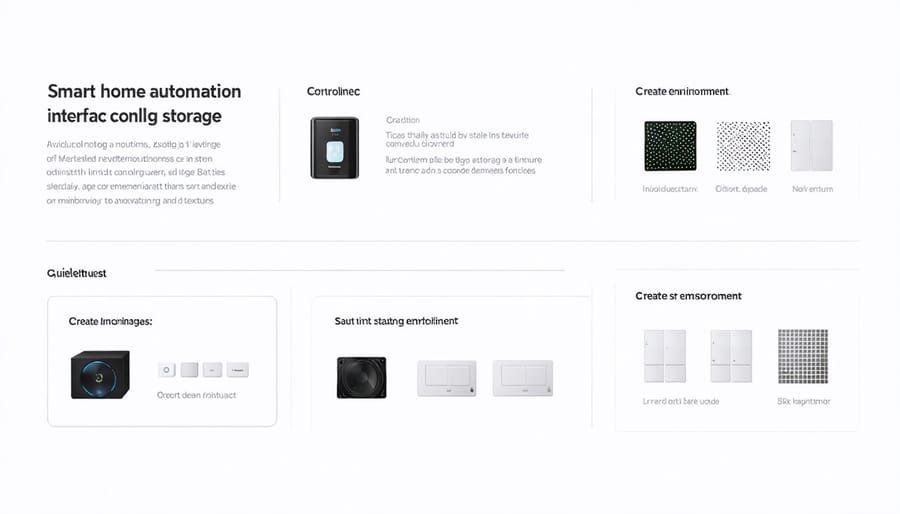Smart Storage Meets Solar: Transform Your Home’s Energy Organization

Transform your living space into an energy-efficient powerhouse by integrating smart home energy storage solutions with intelligent organization systems. Map your home’s energy consumption patterns, designate specific zones for battery placement, and create a systematic storage hierarchy that maximizes both space utilization and power management efficiency.
Install modular storage units with built-in energy monitoring capabilities in high-traffic areas, allowing seamless integration between your solar system’s power flow and daily household operations. Position energy-intensive appliances strategically near storage units to minimize power loss while maintaining optimal room functionality and aesthetic appeal.
Implement a digital inventory management system that tracks both energy usage and stored items, creating a synchronized ecosystem where power consumption aligns perfectly with storage accessibility. This dual-purpose approach revolutionizes traditional storage concepts by combining energy efficiency with space optimization, resulting in a truly future-proof home environment that serves both practical and sustainable objectives.
Connect your storage solutions to smart home automation systems, enabling real-time monitoring of both energy storage capacity and physical storage utilization through a single, intuitive interface. This integration marks the evolution from simple storage spaces to intelligent, energy-aware environments that adapt to your household’s dynamic needs.
The Evolution of Smart Home Storage
Energy-Aware Storage Systems
Modern storage systems have evolved beyond simple space organization to incorporate sophisticated energy monitoring and management capabilities. These smart storage solutions feature integrated sensors and digital displays that provide real-time information about power consumption, storage capacity, and environmental conditions.
Many systems now come equipped with smart controllers that automatically adjust storage conditions based on energy availability and usage patterns. For instance, temperature-controlled storage units can optimize their cooling cycles during peak solar production hours, while automated ventilation systems maintain ideal conditions while minimizing energy consumption.
The integration of mobile apps and home automation platforms allows homeowners to monitor and control their storage systems remotely. Users can track energy usage trends, receive maintenance alerts, and adjust settings to maximize energy efficiency. Some advanced systems even incorporate predictive analytics to anticipate storage needs and optimize energy distribution throughout the home.
Energy-aware storage solutions particularly benefit households with solar installations by ensuring that stored items are maintained at optimal conditions while making the most of available renewable energy. This smart approach to storage management contributes significantly to overall household energy efficiency and sustainability goals.

Connected Organization Solutions
Modern storage solutions have evolved beyond simple shelving systems, embracing smart technology to revolutionize home organization. IoT-enabled storage systems offer unprecedented control and efficiency through smartphone apps and home automation networks. These intelligent solutions include sensor-equipped cabinets that track inventory, smart wardrobes that suggest outfit combinations, and automated garage systems that maximize space utilization.
The integration of smart sensors allows homeowners to monitor storage conditions, particularly crucial for temperature-sensitive items or valuable collections. Motion-detected lighting systems illuminate specific storage areas when needed, while smart locks provide secure access management for family members. Some advanced systems even feature predictive analytics, helping households maintain optimal stock levels of everyday essentials.
Connected organization solutions also facilitate better energy management by integrating with home automation systems. Smart storage units can be programmed to operate during off-peak energy hours, particularly beneficial for homes with solar installations. The real-time monitoring capabilities help identify usage patterns, enabling homeowners to optimize their storage spaces while maintaining energy efficiency.
This technological integration represents a significant step forward in home organization, offering convenience, security, and enhanced functionality for modern households.
Optimizing Storage for Solar Integration
Battery Storage Spaces
Creating a dedicated space for solar battery storage requires careful planning and adherence to safety guidelines. Your battery storage area should be well-ventilated, temperature-controlled, and protected from extreme weather conditions. Ideally, locate your storage space in a covered area like a garage or utility room, maintaining temperatures between 10-30°C for optimal performance.
Ensure the space is dry and elevated to prevent water damage, with proper drainage systems in place. The floor should be level and capable of supporting the significant weight of battery units. Installing proper battery management systems is crucial for monitoring performance and maintaining safety standards.
Consider accessibility for maintenance and potential future expansion when designing your storage space. Allow at least 60cm clearance around all sides of the battery units for proper ventilation and service access. Install appropriate fire safety equipment, including smoke detectors and fire extinguishers rated for electrical fires.
For indoor installations, ensure proper ventilation through mechanical systems or natural airflow. Install vapor-proof lighting fixtures and clearly mark emergency exits and shutdown procedures. The storage area should be secured with restricted access to prevent unauthorized handling while remaining easily accessible for maintenance personnel.
Remember to check local building codes and regulations, as specific requirements may vary by region and installation size. Document your storage setup and maintain regular inspection schedules to ensure long-term safety and efficiency.

Equipment Organization Systems
Proper organization of solar equipment is crucial for system efficiency and maintenance accessibility. For inverter installations, wall-mounted cabinets offer an ideal solution, keeping sensitive equipment protected while maintaining good ventilation. These cabinets should be installed in dry, temperature-controlled areas, preferably in utility rooms or garages, with sufficient clearance for heat dissipation and maintenance access.
Monitoring equipment requires strategic placement for optimal signal strength and easy viewing. Consider installing a dedicated monitoring station that includes a mounted tablet or display screen, ensuring real-time system performance data is readily accessible. Cable management solutions, such as conduit systems or cable trays, help maintain a clean, professional appearance while protecting wiring from environmental factors.
For smaller components and maintenance tools, modular storage systems work effectively. Install pegboards or tool organizers near the inverter area for frequently used items. Label everything clearly using weather-resistant tags or labels to ensure quick identification during maintenance or emergencies.
Documentation storage is equally important. Install a weather-resistant document holder near the equipment area for system manuals, warranties, and maintenance records. Consider creating a digital backup of all documentation and storing access credentials in a secure but accessible location.
Remember to leave adequate space for future system expansion and maintain clear access paths to all equipment. This forward-thinking approach ensures your storage solution remains practical as your solar system evolves.
Smart Storage Solutions for Energy Efficiency
Temperature-Controlled Storage
Temperature control plays a crucial role in maintaining the longevity and efficiency of your energy storage equipment. Modern storage solutions incorporate smart climate management systems that protect sensitive components while optimising performance throughout the year.
For battery storage systems, maintaining a stable temperature between 15-25°C is essential. Consider installing dedicated ventilation systems or climate-controlled cabinets that regulate both temperature and humidity. These specialised units often feature automated monitoring systems that alert you when conditions deviate from optimal ranges.
Wall-mounted storage solutions with built-in thermal management are increasingly popular among European homeowners. These units typically include passive cooling features and temperature-sensitive ventilation grids that respond to environmental changes automatically.
For garage or basement installations, consider implementing zone-specific climate control. This approach allows you to maintain ideal conditions for your energy equipment without unnecessarily cooling or heating the entire space. Smart sensors can integrate with your home automation system, providing real-time monitoring and adjustment capabilities.
Insulation plays a vital role in temperature-controlled storage. High-quality thermal barriers and weather-sealed enclosures help maintain consistent conditions while reducing energy consumption. Consider installing reflective barriers in areas exposed to direct sunlight and ensuring proper air circulation around your storage units.
Remember to position your storage solutions away from heat-generating appliances and direct sunlight when possible. This simple yet effective strategy can significantly reduce the energy needed for temperature regulation while extending equipment lifespan.

Automated Organization Systems
Modern storage solutions have evolved beyond simple shelving systems, incorporating intelligent technology to maximize efficiency and complement renewable energy installations. Smart storage systems now feature automated inventory tracking, climate control monitoring, and AI-powered storage optimization capabilities that work seamlessly with home energy management systems.
These automated solutions typically include sensor-equipped containers that track contents, smart labels with QR codes for easy identification, and mobile apps that provide real-time inventory updates. Integration with home automation systems allows for temperature and humidity control in storage areas, ensuring optimal conditions for sensitive items while maintaining energy efficiency.
Motion-activated lighting systems illuminate storage spaces only when needed, contributing to energy conservation. Advanced organizational systems can even predict usage patterns and suggest optimal storage arrangements based on frequency of access and seasonal requirements.
For homes with solar installations, these smart storage solutions can be programmed to operate during peak solar production hours, maximizing the use of clean energy. The systems can automatically adjust climate control settings and operate ventilation systems based on weather conditions and energy availability, creating a truly sustainable storage environment that works in harmony with your home’s renewable energy infrastructure.
Implementation and Integration Tips
Professional Installation Considerations
When implementing professional storage solutions, proper installation is crucial for both functionality and safety. Begin by conducting a thorough assessment of your space, including load-bearing capacity of walls and floors, electrical requirements for smart storage systems, and accessibility needs. Ensure all measurements are precise and account for door swings, drawer extensions, and clearance spaces.
For wall-mounted systems, locate and mark studs or use appropriate anchoring systems rated for the expected weight load. Smart storage solutions often require power sources and network connectivity – plan cable routing discretely while maintaining easy access for maintenance. Consider integration points with existing home automation systems for seamless operation.
Professional installers should verify compliance with local building codes, particularly for electrical connections and structural modifications. For modular systems, follow manufacturer-specific assembly sequences and use recommended hardware. Pay special attention to leveling and alignment, as these factors significantly impact both aesthetics and functionality.
Leave adequate space for future expansion and ensure all smart features are properly configured and tested before completing the installation. Document all modifications and keep manufacturer guidelines for future reference.
Maintenance and Upgrades
Regular maintenance and timely upgrades are crucial for maximizing the efficiency of your home storage solutions. Start by implementing a quarterly inspection schedule to check for wear and tear, ensuring all components are functioning optimally. When maintaining solar storage systems, pay special attention to ventilation, temperature control, and connection points.
Smart storage systems benefit from periodic software updates that enhance functionality and security features. Set up automatic notifications for available updates and schedule them during off-peak hours. Consider upgrading storage management systems every 3-5 years to take advantage of improved technology and energy efficiency innovations.
Keep detailed maintenance records and create a digital inventory of your storage components. This documentation helps track system performance and identifies areas requiring attention. For optimal results, engage with certified technicians for annual professional assessments and necessary upgrades. Remember to regularly clean sensors, check battery health indicators, and calibrate smart monitoring devices to ensure accurate performance tracking and extended system life.
The integration of smart storage solutions has revolutionized how European homeowners approach organization and space management. By combining traditional storage methods with innovative technology, these systems offer unprecedented control, efficiency, and convenience in managing household items and energy resources. The implementation of smart sensors, automated inventory systems, and energy-efficient storage units has demonstrated significant improvements in home organization while contributing to overall sustainability goals.
Looking ahead, the future of home storage solutions appears increasingly sophisticated. We can expect to see more AI-driven storage systems that learn from household patterns and automatically adjust to changing needs. The integration with existing smart home ecosystems will become more seamless, allowing for better coordination between energy management, storage optimization, and daily living requirements.
The benefits extend beyond mere organization – these solutions contribute to reduced energy consumption, lower maintenance costs, and increased property value. For European homeowners, this represents a strategic investment in both immediate comfort and long-term sustainability. As technology continues to evolve, we can anticipate even more innovative features that will further enhance the efficiency and functionality of home storage systems.
The successful adoption of integrated smart storage solutions marks a significant step forward in modern home management, promising a future where organization and energy efficiency work hand in hand to create more sustainable, comfortable living spaces.
Leave a Reply